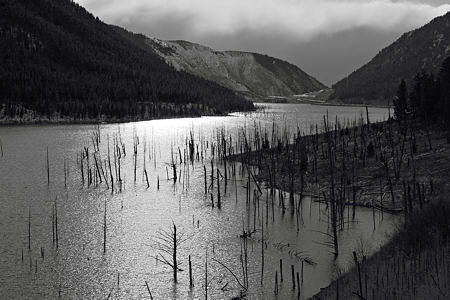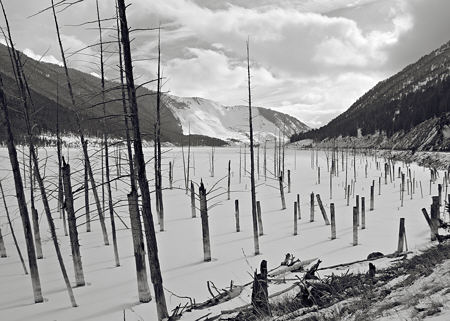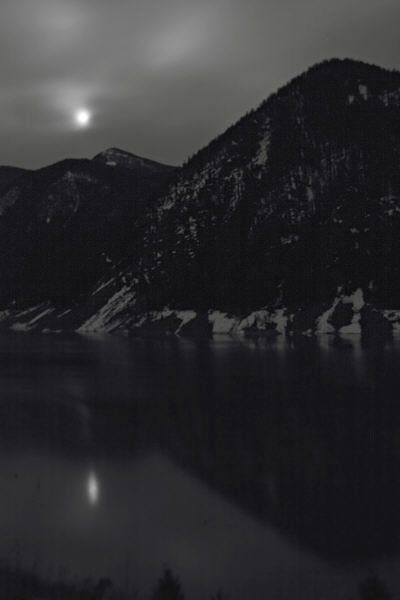The biggest recorded earthquake in Montana history (magnitude 7.3) struck August 17, 1959, causing a huge landslide that dammed the Madison River (coming from Yellowstone Park) and created Quake Lake. Some 26-28 campers lost their lives, most of the bodies remaining under the millions of tons of rock. To me, they seem connected to the much larger number of trees that were drowned by the rising water, but remained standing bare, half-submerged.

Quake Lake is about two hours from Bozeman, and I’ve visited several times. I have made well over a hundred photographs of the place, but not one I’ve considered worth printing. Scenic and evocative as it is, it eludes me yet. True, I haven’t been there in over a year (nearly half my recent photographic career!), and I want to believe I could do a better job now. I’m certainly anxious to try.

Quake Lake has some great features, from the sparkling water to the skeletal trees to the ripped-out mountainside (at the end of the lake, marked by snow in these images) that slid into the valley. It may be the very strength of these subjects that makes them hard for me to photograph well. Am I too drawn to the subject to be thinking about the picture?

What I may need most is simply time, time to explore and to wait for the light, perhaps, if I remember, time to close my eyes and listen. Once I did stay overnight (yes, Jay, on the ground), but left early for someplace else. The photographs have yet to plumb the depths.

Steve,
in your first image, I would have left more of the clouds, thinking that they perhaps would give an interesting relationship to the curvature of the water course.
I love your last picture. Rotating it 90oCW, I studied the reflection in the water. Are reflections always distorted this way or does it depend on landscape? Rotated this way, the grey shapes on the shore are suggestive of faces on a totem pole.
Steve,
Great pictures. I will be interested to see #3 in color (if you have it).
Sunil
“Am I too drawn to the subject to be thinking about the picture?”
That’s what makes for a great story behind the picture – sometimes makes it more meaningful…
Are pictures #1 and #2 of the same spot – just taken at different times (summer/winter)?
From the vistas, it looks like it is.
Birgit,
Good thought. That’s exactly the kind of compositional consideration that could make for a much better image. If I’d had some hours or a day there, I could have waited and hoped for better cloud arrangements.
Sunil,
I don’t have #3 prepared in color, but it would look almost the same: gray sky, dark, dark trees against white snow, and the reflections of these in the water are all nearly colorless.
The importance of subject is different for different viewers and different kinds of images. People can care tremendously about a snapshot of a loved one that may have no interest whatever for anyone else. I do care about this subject, but I don’t think I’ve represented it in a way that would make anyone else care too much. The pictures are like those snapshots, little to recommend them outside the intrinsic interest of the subject. I’m not saying they’re worthless, but they’re not as much as I want them to be.
You’re right, photo #2 is taken from the point visible in the middle ground of #1, so the angle down the lake is similar.
Steve,
I keep thinking that the first photo _should_ work, but for whatever reason, it isn’t as dramatic as I think it is. If that makes sense. The dead trees are like tombstones; they are also absolutely vertical, cutting across the zigzag of the lake. The play of light is interesting. And yet, the scene is almost placid, taking itself for granted.
I like your paragraph about the importance of subject. This is a photo which reminds me of photos of places I love, which no one else realates to as I do.
Maybe Birgit’s right about the clouds. Or maybe the angle could be changed. I think you need to camp out there for a week and take a lot of photos. But maybe wait until next summer. The thought of the cold hard ground in November makes my bones ache.